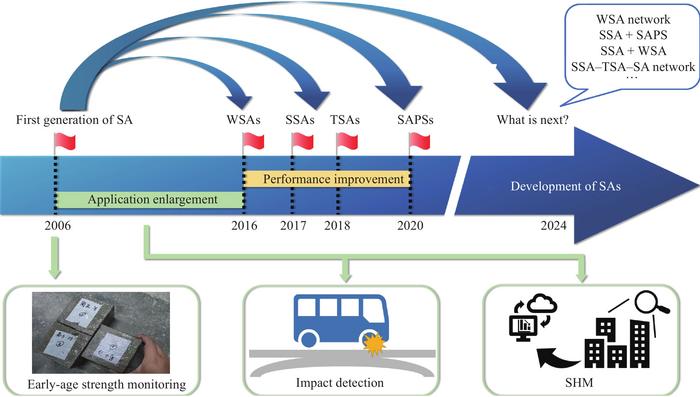The proliferation of concrete infrastructure worldwide has been met with growing concerns over its durability and safety. Concrete structures are increasingly subjected to dynamic forces from natural disasters like earthquakes and environmental degradation, such as corrosion. These factors, coupled with the saturation of infrastructure projects, amplify the risks associated with structural failure. Consequently, there is a pressing need for effective structural health monitoring (SHM) systems that can preemptively identify and address these vulnerabilities. The development of piezoelectric smart aggregates (SAs) emerges as a promising solution to this critical challenge, paving the way for enhanced resilience in our built environments.

Credit: Pengfei Li, Chongqing Jiaotong University
The proliferation of concrete infrastructure worldwide has been met with growing concerns over its durability and safety. Concrete structures are increasingly subjected to dynamic forces from natural disasters like earthquakes and environmental degradation, such as corrosion. These factors, coupled with the saturation of infrastructure projects, amplify the risks associated with structural failure. Consequently, there is a pressing need for effective structural health monitoring (SHM) systems that can preemptively identify and address these vulnerabilities. The development of piezoelectric smart aggregates (SAs) emerges as a promising solution to this critical challenge, paving the way for enhanced resilience in our built environments.
Researchers from Tsinghua University, in collaboration with various institutions, have made significant progress in the development of piezoelectric SAs for SHM. Published in the Journal of Intelligent Construction on June 18, their review (DOI: 10.26599/JIC.2024.9180016) highlights the latest advancements in SA technology, emphasizing its potential in real-world applications.
The review highlights significant advancements in piezoelectric SAs for SHM. SAs, embedded in concrete, are designed to monitor early-age concrete strength, detect impacts, and continuously assess structural health. The research emphasizes three main areas: technological advancements, expanded measurement ranges, and the integration of wireless communication. Notable developments include multidimensional SAs that improve detection accuracy and range, and wireless SAs (WSAs) that streamline data collection and reduce maintenance costs. Practical applications discussed include real-world scenarios such as crack monitoring and repair quality assessment in concrete structures. These innovations demonstrate the substantial benefits of SA technology in enhancing the durability and safety of infrastructure, providing a comprehensive solution for modern SHM needs.
Dr. Pengfei Li, a key contributor to the research commented, “The advancements in piezoelectric SAs represent a significant leap forward in SHM. The integration of wireless technology and the development of multidimensional SAs provide a robust framework for ensuring the safety and longevity of modern infrastructures.”
The implementation of advanced piezoelectric SAs in SHM has profound implications for infrastructure maintenance and safety. These innovations enable continuous, real-time monitoring, allowing for early detection of potential issues and timely interventions. The advancements in SA technology promise to enhance the durability and reliability of structures, reduce maintenance costs, and improve overall safety, marking a new era in infrastructure management.
This work was sponsored by the Open Research Fund Program of the State Key Laboratory of Hydroscience and Engineering (No. sklhse-2023-C-05) and the Natural Science Foundation of China (No. 52378267).
About Journal of Intelligent Construction
Journal of Intelligent Construction (JIC), sponsored by Tsinghua University and the China National Committee on Large Dams, published by Tsinghua University Press (TUP) and exclusively available via SciOpen, is a peer-reviewed journal for publishing original research papers, case studies, reviews and comments regarding the use of novel technologies in all domains of civil engineering, e.g., hydraulic engineering, structural engineering, geotechnical engineering, transportation, and construction management. The journal focuses on the application of advanced theories, methodologies, and tools, such as machine learning, sensors, robotics, 5G, the Internet of Things, artificial intelligence, building information modelling, and computational methods, etc., in all stages of the construction life cycle, which makes the process more intelligent and efficient. The journal also covers other essential areas of civil engineering, e.g., planning and design, operation and maintenance, and disaster mitigation.
About SciOpen
SciOpen is an open access resource of scientific and technical content published by Tsinghua University Press and its publishing partners. SciOpen provides end-to-end services across manuscript submission, peer review, content hosting, analytics, identity management, and expert advice to ensure each journal’s development. By digitalizing the publishing process, SciOpen widens the reach, deepens the impact, and accelerates the exchange of ideas.
Journal
Journal of Intelligent Construction
Article Title
Advances in the development of piezoelectric smart aggregates for structural health monitoring
Article Publication Date
18-Jun-2024



